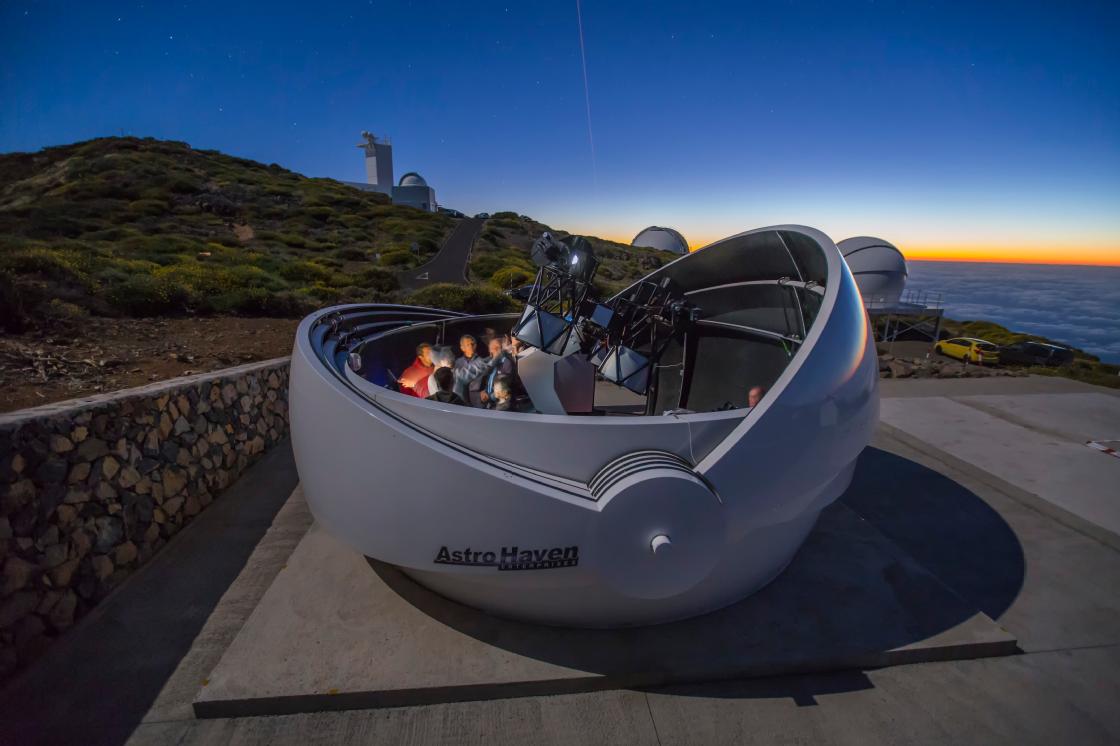The GOTO Guy

Danny Steeghs of the University of Warwick’s Astronomy and Astrophysics Group is a happy man. Not only have he and fellow researchers and collaborators designed and built a telescope to ‘see’ the origins of exotic cosmic explosions – but the instrument is now operational and sending back data from La Palma in the Canary Islands.
The Gravitational-wave Optical Transient Observer (GOTO) is an autonomous, intelligent telescope, which will search for unusual activity in the sky with the aim of detecting optical signatures of sources of gravitational waves. Gravitational waves are the very latest route to understanding the origins of stars and have the potential key to understanding gravity itself as the loudest waves are produced by the most extreme objects.
Location, location, location
GOTO’s position, wedged high on the outer wall of an extinct volcano in the middle of the Atlantic, at Warwick’s astronomical observing facility in the Roque de los Muchachos Observatory of the Instituto de Astrofísica de Canarias on La Palma is one of international envy. To have a platform of your own on La Palma is a huge achievement and is down to years of collaborative work.
“If you look around the Roque de los Muchachos observatory it’s full of some really big telescopes – both in name and size,” explains Danny Steeghs, who is the principal investigator on GOTO. “The UK has been on La Palma, along with Spain and the Netherlands, right from the start when the site was becoming established more than 30 years ago and Warwick has been involved here for many years. There is competition for plots as you would expect – there is a strong community of researchers and astronomers producing top-class work. We are lucky to have our own facility because rather than having to bid for time on a shared telescope to carry out the work, we are able to carry out active research every dark minute of the year. Crucially GOTO was specifically designed for this search and can thus be more effective than larger general purpose telescopes.”
What an atmosphere
But a position on La Palma isn’t desirable because of its winter sun and beautiful beaches as you or I may conclude. The island offers one of the best clear sky observation locations in the Northern Hemisphere and indeed the world.
Dr Steeghs explains: “It’s all to do with the quality of the atmosphere. You could locate a telescope in the desert where there is no light pollution, or in the Himalayas, where you have the benefit of altitude, but these locations suffer from air turbulence and/or adverse weather. Volcanic islands like La Palma, rise up steeply out of the sea. La Palma itself rises 2.5 kilometres straight up. It’s high enough to put you above the clouds most of the time, offering clear skies with very good image quality. La Palma is really in the top five or so places in the world for observatories along with Hawaii and the dry mountain plateaus of the Chilean Andes. We are very lucky to have secured a position here.”
GOTO may be designed and custom-manufactured, but it is only in its first phase. It exploits smaller and more economical telescopes and instruments, using off-the-shelf parts were possible. To the lay-person it already looks impressive, housed in its futuristic ‘egg-cup’, set against the Canary Isles sunset. But if you look around the site at La Palma, there is a large platform stood empty next to the GOTO dome. The full GOTO is still to be built.
Dr Steeghs continues: “This is only part of the work – it’s the initial stages. We want to confirm what the capabilities are before we build up the full facility. We aim to have a whole family of equipment here eventually and the next batch is about to be ordered."
Eyes to the sky
Wave detectors, such as the Advanced Laser Interferometer Gravitational-Wave Observatory (aLIGO), which secured media attention for making the first direct detections of gravitational waves recently, are already up and running so speed was of the essence with the GOTO project.
“With the technology already in place to start detecting gravitational waves, we wanted to build the machine which could ‘see’ where they are coming from,” says Dr Steeghs. “It was important to start to get results as soon as possible. Our array of telescopes is designed to be fast and responsive. Our system to find the optical signal of a gravitational wave kicks into action after we receive an alert from the wave detectors. The laser interferometer detects the wave itself – essentially it shakes a laser beam. When this happens we receive electronic alerts which are picked up by our computer and the information is digested. We can then remotely, and automatically, point the telescope to observe the particular area of the sky from where the signal has come.
“GOTO is sensitive to optical light - it basically takes a picture of the sky in the direction of the signal. We end up with digital images of dots – white field objects in the night sky. Within each of these images is huge amounts of data to process.
“Our main goal is to chase the short–lived gravitational wave signals to pinpoint the source of the wave. But we happen to have built something which categorises the sky all the time, so we are also collecting loads of secondary data – so we can begin to look for other things like supernova explosions. These data will keep us busy for years!”
Built with purpose
The amazing thing about the project is that Danny and the team don’t really know what they are looking for.
“We are still guessing what sort of signal we’ll see – educated guessing, but still guessing," he says. "Also we have no control over when it will happen. It may happen tomorrow – it might be a life’s work. It’s very exciting as other people in the world are also trying – but they are using what they have. We know we built this with the purpose of finding gravitational waves. There are no guarantees, but we think, with hard work and bit of luck, we may find them with GOTO.”
GOTO is the latest addition to the University of Warwick’s astronomical facility at La Palma, which includes the SuperWASP Exoplanet discovery camera - the most successful ground based exoplanet discovery project in existence.
Funded via a Major Initiative of the Monash-Warwick Alliance as well as contributions from Armagh Observatory, Sheffield, Leicester and Thailand's NARIT, GOTO was inaugurated at in July at a ceremony attended by Professor Pam Thomas, the University of Warwick’s Pro-Vice-Chancellor (Research), who spoke on behalf of the university at the inauguration ceremony, and unveiled the plaques on GOTO.
Published
25 August 2017
 Danny Steeghs is Reader in the Astronomy & Astrophysics group within the Department of Physics at the University of Warwick. He is an observationally focused astronomer, exploiting the spectrum of facilities available to us including the Hubble Space Telescope, X-ray satellites such as XMM and SWIFT and a wide range of ground-based observatories. He is Warwick's project lead on GOTO.
Danny Steeghs is Reader in the Astronomy & Astrophysics group within the Department of Physics at the University of Warwick. He is an observationally focused astronomer, exploiting the spectrum of facilities available to us including the Hubble Space Telescope, X-ray satellites such as XMM and SWIFT and a wide range of ground-based observatories. He is Warwick's project lead on GOTO.
Images
Guests at the inauguration of The Gravitational-wave Optical Transient Observer (GOTO) - credit Antonio González / IAC
Terms for republishing
The text in this article is licensed under a Creative Commons Attribution 4.0 International License (CC BY 4.0).
Share

